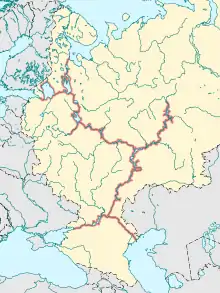Unified Deep Water System of European Russia
The Unified Deep Water System of European Russia (Russian: Единая глубоководная система Европейской части Российской Федерации) or UDWS (Russian: ЕГС) is a system of inland waterways in Russia linking the White Sea, the Baltic Sea, the Volga River, Moscow, the Caspian Sea and—via the Sea of Azov—the Black Sea. In 2010, UDWS carried 70 million tons of cargo and 12 million passengers, making up two-thirds of overall inland waterway traffic volume in Russia.[1] There are 60 common-use ports and quays in the UDWS,[1] including three international ports (two in Moscow and one in Dmitrov, Moscow Oblast), so Moscow is sometimes called "the port of the five seas".

The depth is mostly guaranteed at only 4 metres (13 ft) and some sections are even shallower, such as Gorodets–Nizhny Novgorod at 2.5 metres (8.2 ft) and Kochetovsky Bagayevskaya at 3.2 metres (10 ft). There are plans to increase depth of these sections to 4 m.[1]
The system includes these waterways:
- Neva River
- Lake Ladoga
- Svir River
- Lake Onega
- Volga–Baltic Waterway — connects Lake Onega to the Volga River; built in the early 19th century as Mariinsk Canal System and rebuilt in 1956–1964
- White Sea–Baltic Canal — connects Lake Onega to the White Sea; constructed in 1931–1933
- Moscow Canal — connects Moscow to the Volga River; constructed in 1932–1937
- Volga River
- Kama River
- Belaya River
- Volga–Don Canal — connects the Volga River to the Don River; constructed in 1948–1952
- Don River
Environmental impact
In 1999, the warty comb jelly colonized the Caspian Sea via the UDWS. The establishment of this population led to a 60% reduction in the number of sprat, which in turn led to a reduction in the population of sturgeon and seals.[2]
In total, according to the unified federal/state agency CaspNIRKh (Russian: КаспНИРХ), about 60 alien species of plants and animals penetrated into the Caspian Sea in the 20th century, which has led to significant changes to ecosystems.[3]
See also
References
- "Единая глубоководная система России и проблемы повышения эффективности ее использования" (PDF). Транспорт Российской Федерации. 2011.
- Zarina Akhmedova (November 8, 2010). "Борьба против вредоносного мнемиопсиса в водах Каспия дала первые результаты - минэкологии" [Initial Results in the Fight Against the Malicious Mnemiopsis in Caspian Waters – Ministry of the Environment]. Trend News Agency. Retrieved September 14, 2016. (in Russian)
- "РЕШЕНИЕ – Пленарного заседания Научного консультативного совета по комплексному использованию водных ресурсов и охране водных экосистем по вопросу: "Экологические последствия предлагаемых вариантов строительства второй нитки Волго-Донского водного пути или канала "Евразия" (18 марта 2009 г., г. Москва)" [Decision – Plenary meeting of the Scientific Advisory Board for the Integrated Water Resources Management and Protection of Water Ecosystems on the Issue: "Environmental Impact of the Proposed Options for the Construction of the Second Line of the Volga-Don Waterway or Canal" Eurasia "(18 March 2009, Moscow)]. Water and the People: 21st Century. Water Safety Science and Technology Center. March 18, 2009. Missing or empty
|url=(help) (in Russian)